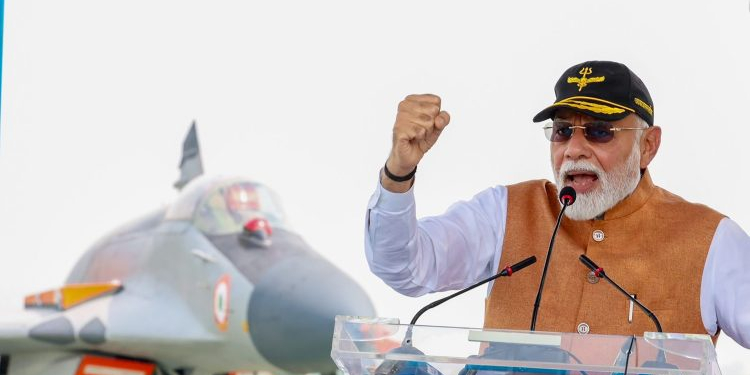SOURCE: IDRW.ORG


In a bold and confident press briefing, the Indian Army took a swipe at Pakistan’s much-touted Turkish-made drones, declaring them ineffective against India’s robust air defence systems. “You must’ve seen what we did to those overhyped Turkish drones launched by Pakistan,” quipped a senior Indian Army official, highlighting the decisive neutralization of over 500 Turkish SONGAR and Byker YIHA III kamikaze drones in the past four to five days of intense cross-border operations. The statement, laced with a touch of mockery, underscored India’s technological and operational superiority in countering Pakistan’s aerial aggression during the ongoing conflict.
The Indian Army’s Air Defence (AAD) units, backed by advanced counter-unmanned aerial systems (C-UAS), have demonstrated remarkable efficiency in thwarting Pakistan’s drone-based offensives. According to official sources, Pakistan launched approximately 300 to 400 drones, including Turkish-made Asisguard SONGAR and Byker YIHA III kamikaze models, across 36 locations from Leh to Sir Creek on the nights of May 7-9, 2025, targeting military installations and civilian areas. These drones, armed with high-explosive payloads, were intended to strike key zones like Amritsar and Bathinda but were swiftly intercepted by India’s layered air defence grid.
Continue readingSOURCE: IDRW.ORG


Renowned Austrian combat aviation expert Tom Cooper, a globally respected authority on air warfare, has declared India’s recent air campaign against Pakistan a “clear-cut victory,” delivering a stinging rebuke to Western media narratives and reinforcing India’s military dominance in the ongoing conflict. In a detailed blog post analyzing the India-Pakistan clashes that escalated following India’s Operation Sindoor on May 7, Cooper dissected the operational and strategic dynamics, highlighting India’s unmatched firepower and Pakistan’s inability to mount an effective response. His analysis, combined with insights from other military experts like retired U.S. Army officer John Spencer, underscores India’s emergence as a formidable regional power with battle-proven indigenous defence systems.
Tom Cooper, whose extensive studies of air wars span conflicts in the Middle East, Africa, and South Asia, is no stranger to dissecting complex military engagements. His latest blog post, published on May 12, 2025, has sent ripples through defence circles, as he categorically affirmed India’s air campaign as a decisive triumph. “When one side is bombing nuclear weapons storage facilities of the other, and the other has no ability to retaliate left, then that’s a clear-cut victory in my books,” Cooper wrote, pointing to India’s precision strikes on critical Pakistani military infrastructure, including suspected nuclear storage sites.
Continue readingSOURCE: AFI


The Indian Air Force’s (IAF) deployment of the BrahMos-A supersonic cruise missile from its Sukhoi Su-30MKI fighters during the May 2025 India-Pakistan conflict has redefined the role of multirole fighters as mini-bombers, delivering devastating precision strikes with unparalleled speed and range. The BrahMos-A’s success in crippling Pakistani air bases and terrorist infrastructures, as part of Operation Sindoor, underscores its transformative impact on India’s air campaign.
However, this achievement also highlights a critical gap in the IAF’s arsenal: the absence of a dedicated stealth bomber capable of delivering heavy payloads deep into enemy territory with minimal detectability. Leveraging the technological advancements of the Advanced Medium Combat Aircraft (AMCA) program, India must prioritize the indigenous development of a 50-ton stealth bomber to enhance its strategic deterrence and ensure long-term air dominance.
Continue readingSOURCE: AFI


The Indian Air Force’s (IAF) Sukhoi Su-30MKI, often dubbed the “Monster” for its formidable size, agility, and combat prowess, has once again proven its mettle in the skies. Following its celebrated evasion of multiple AIM-120C-5 AMRAAM missiles during the 2019 Balakot skirmish, the Su-30MKI reportedly dodged Chinese-supplied PL-15E beyond-visual-range (BVR) air-to-air missiles and HQ-9BE surface-to-air missiles (SAMs) during the India-Pakistan conflict that erupted in May 2025.
This remarkable feat, achieved despite the aircraft lighting up on enemy radars, underscores the Su-30MKI’s advanced electronic warfare (EW) capabilities, superior maneuverability, and the skill of IAF pilots. As posts on X and defense analyses celebrate this achievement, the Su-30MKI cements its reputation as a near-invincible platform in modern aerial warfare.
Continue readingSOURCE: AFI


In a striking rebuttal to Pakistan’s propaganda, Prime Minister Narendra Modi’s recent visit to the Adampur airbase in Punjab showcased India’s intact S-400 air defense system, debunking Islamabad’s claims of its destruction. The high-profile visit not only dismantled Pakistan’s narrative but also underscored Modi’s unwavering commitment to India’s national security.
During the visit, the S-400 system, a cornerstone of India’s air defense, was prominently visible in pristine condition. This directly contradicted Pakistan’s boastful assertion that its JF-17 fighter jets had launched missiles to destroy the sophisticated Russian-made system at Adampur. The Pakistani military had circulated what it claimed was a satellite image of a “damaged S-400,” circling a nondescript patch of dirt and proclaiming, “S-400 damaged!!!” The image, lacking any credible evidence, was swiftly exposed as a fabrication when Modi’s visit revealed the system unscathed.
Continue readingSOURCE: AFI


The India-Pakistan conflict of May 2025, ignited by the April 22 Pahalgam terror attack and intensified by India’s Operation Sindoor, has taken a disturbing turn with allegations that Pakistan deliberately tried to provoke a catastrophe reminiscent of the 2014 Malaysia Airlines Flight 17 (MH17) shootdown.
Social media posts on X and unverified reports suggest Pakistan sought to lure international civilian airliners into its airspace, hoping Indian air defense systems (ADS) would mistakenly shoot them down, thereby framing India for a tragedy akin to MH17, which was downed by Russian-backed forces in eastern Ukraine. While no such incident occurred, the closure of Pakistani airspace to Indian carriers and rerouting of international flights highlight the dangerous brinkmanship. This article critically examines these claims, the context of the conflict, and the parallels with MH17, emphasizing the need for skepticism amid wartime disinformation.
Continue readingSOURCE: AFI

The recent India-Pakistan conflict, sparked by the April 22, 2025, Pahalgam terror attack and culminating in India’s Operation Sindoor, has been overshadowed by a series of mild earthquakes in Pakistan, raising questions about their origins. Between April 30 and May 12, four earthquakes of magnitudes 4.0 to 4.7 struck regions near Punjab and Khyber Pakhtunkhwa, coinciding with intense military engagements. Social media platforms, particularly X, have been abuzz with conspiracy theories suggesting these tremors were either covert Pakistani nuclear tests to signal resolve or the result of Indian strikes damaging Pakistan’s nuclear facilities, such as those at Kirana Hills or Sargodha.
Official statements from India’s National Centre for Seismology (NCS) and the Indian Air Force (IAF) dismiss these claims, but the timing and location of the quakes continue to fuel speculation. This article examines the evidence, the context of the conflict, and the plausibility of these theories, urging a critical approach to separating fact from conjecture.
Continue readingSOURCE: IANS


Prime Minister Narendra Modi on Tuesday morning visited the Adampur Airbase in Punjab, where he met with Indian armed forces personnel and saluted their courage, declaring that he had come to have the “darshan of the heroes” who defended the nation with fearlessness and dedication.
Addressing the soldiers amid chants of ‘Bharat Mata ki Jai’, PM Modi said, “This slogan is not just a proclamation but a vow of every soldier who is willing to give his life to protect Maa Bharti. This is the voice of every citizen who wants to serve the country. This voice resonates both in the field and in the mission.”
Continue readingSOURCE: PTI

Maharashtra Cyber has identified seven Advanced Persistent Threat (APT) groups responsible for launching over 15 lakh cyber attacks targeting critical infrastructure websites across India following the Pahalgam terror strike.
Of these, only 150 attacks were successful, officials said on Monday. Even after India and Pakistan reached an understanding to stop military hostilities, Indian government websites are facing a barrage of cyber attacks from the neighbouring country as well as from Bangladesh and the Middle Eastern region, they said.
Continue readingSOURCE: IANS
/wion/media/media_files/2025/05/13/yE5pD8FO9X01PGbvIzWR.jpg)

Prime Minister Narendra Modi on Tuesday morning visited the Adampur Airbase in Punjab to meet Indian Air Force personnel and express the nation’s gratitude for their courage and fearlessness in defending the country.
His visit comes just days after India and Pakistan agreed to a ceasefire following the successful execution of ‘Operation Sindoor’, a major anti-terror operation conducted by Indian forces targeting high-value terror hubs in Pakistan and Pakistan-occupied-Kashmir (PoK).
Continue readingSOURCE: PTI

Foreign Secretary Vikram Misri will brief Parliament’s Standing Committee on External Affairs on the current situation with Pakistan on May 19.
The committee’s chairman and Congress MP Shashi Tharoor told PTI Misri will brief the panel on Monday on the developments, which were marked by India striking terror sites in Pakistan followed by days of intense conflict between the two countries before they agreed to stop military actions.
Continue readingSOURCE: PTI

India has extended crucial financial support to the Maldives through the rollover of the $50 million Treasury Bill for one more year, a move the Maldivian Government said would support its ongoing efforts to implement fiscal reforms for economic resilience.
At the request of the Maldivian Government, the State Bank of India (SBI) has subscribed, for one more year, a $50 million Government Treasury Bill issued by the Ministry of Finance of Maldives, the Indian High Commission in the Maldives said in a statement on Monday.
Continue readingSOURCE: PTI


Pakistan on Tuesday said that 11 military personnel were killed and 78 others injured during the recent military confrontation with India. In a statement, the military also claimed that 40 civilians died and 121 others were injured in the “unprovoked and reprehensible dastardly attacks” by India on the night of May 6-7. India and Pakistan reached an understanding on Saturday to end the conflict after four days of intense cross-border drone and missile strikes.
While defending the motherland, 11 personnel of Pakistan’s armed forces were killed and 78 others were wounded, the Pakistan military said. The victims from the Pakistan Air Force include Squadron Leader Usman Yousuf, Chief Technician Aurangzeb, Senior Technician Najeeb, Corporal Technician Farooq and Senior Technician Mubashir, it said. Naik Abdul Rehman, Lance Naik Dilawar Khan, Lance Naik Ikramullah, Naik Waqar Khalid, Sepoy Muhammad Adeel Akbar and Sepoy Nisar were among the army personnel killed in the strikes, it added.
Continue readingSOURCE: ANI

A prominent political analyst from Pakistan-occupied Jammu and Kashmir (PoJK), Amjad Ayub Mirza, has issued a strong statement supporting India’s recent counter-terrorism offensive Operation Sindoor, targeting terror infrastructure in Pakistan and its occupied territories.
Mirza warned that the threat of terrorism from PoJK was far from over. He asserted that the terrorist camps in PoJK have not been dismantled but only relocated after India identified their locations. “The terrorists have been moved from places like Muzaffarabad, Leepa Valley, and other known sites. These camps are very much active — just shifted, not shut,” he said.
Continue readingSOURCE: IANS


Three terrorists were killed on Tuesday in a gunfight with the joint forces in Keller area of Jammu and Kashmir’s Shopian district. V. K. Birdi, IGP (Kashmir), told reporters that three terrorists have been killed.
“Terrorists are yet to be identified, and a search operation is still going on there,” he said. Joint forces had launched a Cordon and Search Operation (CASO) in the Shukroo Keller area of Shopian district after intelligence inputs said that a group of terrorists was hiding there.
Continue reading